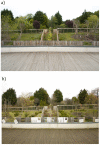Assessing public engagement with science in a university primate research centre in a national zoo
- PMID: 22496822
- PMCID: PMC3319593
- DOI: 10.1371/journal.pone.0034505
Assessing public engagement with science in a university primate research centre in a national zoo
Abstract
Recent years have seen increasing encouragement by research institutions and funding bodies for scientists to actively engage with the public, who ultimately finance their work. Animal behaviour as a discipline possesses several features, including its inherent accessibility and appeal to the public, that may help it occupy a particularly successful niche within these developments. It has also established a repertoire of quantitative behavioural methodologies that can be used to document the public's responses to engagement initiatives. This kind of assessment is becoming increasingly important considering the enormous effort now being put into public engagement projects, whose effects are more often assumed than demonstrated. Here we report our first attempts to quantify relevant aspects of the behaviour of a sample of the hundreds of thousands of visitors who pass through the 'Living Links to Human Evolution Research Centre' in Edinburgh Zoo. This University research centre actively encourages the public to view ongoing primate research and associated science engagement activities. Focal follows of visitors and scan sampling showed substantial 'dwell times' in the Centre by common zoo standards and the addition of new engagement elements in a second year was accompanied by significantly increased overall dwell times, tripling for the most committed two thirds of visitors. Larger groups of visitors were found to spend more time in the Centre than smaller ones. Viewing live, active science was the most effective activity, shown to be enhanced by novel presentations of carefully constructed explanatory materials. The findings emphasise the importance and potential of zoos as public engagement centres for the biological sciences.
Conflict of interest statement
Figures









References
-
- HEFCE. Higher Education Funding Council for England. 2010. Available: http://www.hefce.ac.uk/. Accessed 2010 December 22.
-
- NSF. National Science Foundation. 2010. Available: http://www.nsf.gov/. Accessed 2010 December 22.
-
- CAISE. Center for Advancement of Informal Science. 2010. Available: http://caise.insci.org/. Accessed 2010 November 2.
-
- NCCPE. National Co-ordinating Centre for Public Engagement. 2010. Available: http://www.publicengagement.ac.uk/. Accessed 2010 December 22.
-
- Tanaka M, Nakamichi M, Ross SR. The advancement of cognitive and behavioural research in zoo settings. 2010. International Primate Society Conference 2010 (abstract)
Publication types
MeSH terms
Grants and funding
LinkOut - more resources
Full Text Sources

